
table of contents
- Types from A - C
- Types of D - G
- Types of H - O
- Types of P - U
- Types from V - Z
- frequently asked Questions
As soon as the temperatures are a little warmer in spring or autumn, different beetles appear. Occasionally there are red beetles with black spots, which are mostly beneficial insects.
In a nutshell
- the Asian ladybird is spreading rapidly in Europe
- the most common black dot beetles in the garden are ladybird species
- the fire bug occurs in large groups, but is a beneficial insect
- the twenty-four spotted ladybug is a pest in the garden because it feeds on crops
Types from A - C
Asian Ladybug (Harmonia axyridis)

- Length: 6 - 8 mm
- Appearance: smooth glossy wings; yellowish pronotum with a black mark in the middle that looks like an M or W.
- Diet: Aphids in very large quantities, various insects including local ladybirds
- Special features: imported from East Asia for pest control, since the beginning of the 21. Widespread in Europe during the 19th century
Note: The Asian ladybird has a lot of color morphs, which also earned it the German name Harlequin ladybird. A red beetle with black spots in variable numbers is just one of the colorations that they can take on.
Ant leaf beetle (Clytra laeviuscula)

- Length: 7-11 mm
- Appearance: elongated shape, reddish to orange basic tone, 2 small black spots in the shoulder area, 2 large oval spots in the middle of the wings
- Food: hawthorn, ash, willow
- Special features: larvae feed on larval food or waste products from the ants in ant nests
Ant seven-spotted ladybug (Coccinella magnifica)

This red beetle with black spots is a very good example of a symbiosis because he prefers the proximity of ant colonies, knowing that the ants attack the aphids on plants maintain.
- Length: 6-8 mm
- Appearance: mostly 7 points, sometimes 5 - 11 points, white spots on the middle and rear legs
- Food: aphids
- Special features: optically distinguishable from the seven-point ladybug only by the white spots
Eye spot ladybug (Anatis ocellata)

- Length: 8 - 9 mm
- Appearance: 10 black irregular points with a white-yellow border
- Food: Aphid species on conifers
Types of D - G
Thirteen-point swamp ladybug (Hippodamia tredecimpunctata)

- Length: 5 - 7 mm
- Appearance: elongated body shape, 13 black points, yellowish pronotum with black central point
- Food: aphids
- Special features: preferably wet biotopes with special plants such as sedges, rushes, reeds, willows
Eleven-spotted ladybird (Coccinella undecimpunctata)
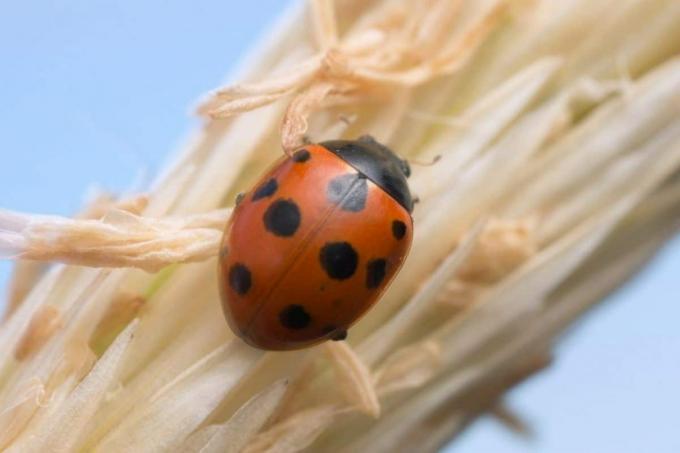
- Length: 4 - 5 mm
- Appearance: 7-11 black points, occasionally the points merge with one another or have a yellowish border
- Food: aphids, preferably cup scale insects
- Special features: ladybird brackish wasp as a parasitic enemy
Fire bug (pyrrhocoris apterus)

- Length 6.5 - 12 mm
- Appearance: 2 distinctive large black spots, 2 smaller black spots, 1 large black triangle on the neck, 1 spot on the neck and abdomen
- Food: seeds of linden, mallow family, locust trees, dead insects
- Special features: occurs in large groups, not a plant pest
Tip: If you disturb these red beetles in the garden, you can prevent them from occurring in large numbers simply by removing the leaves from under their favorite food plants in autumn.
Five-spot ladybug (Coccinella quinquepunctata)

- Length: 3 - 5 mm
- Appearance: 1 large and 2 small black spots on each wing, 1 large central spot with two white spots on the side
- Food: aphids
- Special features: appearance similar to the seven-point ladybug, but significantly smaller
Spotted willow leaf beetle (Chrysomela vigintipunctata)

- Length: 6.5 - 8.5 mm
- Appearance: 10 black oval points per wing cover
- Food: willow, poplar, birch, alder
- Special features: basic color varies whitish, yellowish and reddish
Types of H - O
Heart-spotted hooded leaf beetle (Cryptocephalus cordiger)

- Length: 5.5 - 6.5 mm
- Appearance: heart-shaped white spot on a black background on the pronotum, 2 black spots per wing cover
- Food: oak, hazelnut, birch, various rose plants such as sparaceous bushes
- Special features: The larvae are made of their own stuck-together feces
Scarce (Spilostethus saxatilis)

- Length: 8.5 - 12.5 mm
- Appearance: black spots of various shapes, black-red dots on the rear edge
- Diet: Striped fern family, daisy family, umbelliferae
- Special features: flyable bug species, distribution to central Germany, only rarely in northern Germany
Cross-banded mushroom beetle (Mycetina cruciata)

- Length: 3.8 - 4.5 mm
- Appearance: four black spots that grow together to form a cross in older specimens
- Food: Fungi such as tinder sponge, red-rimmed tree sponge, flat lacquer sponge, butterfly tramete
- Special features: prefers to live in higher regions above 1300 m, both larvae and beetles feed on fungi
Osier leaf beetle (Gonioctena viminalis)
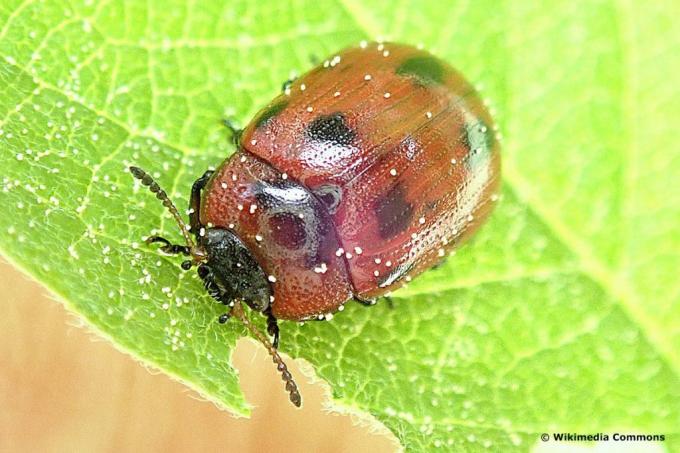
- Length: 5.5 - 7 mm
- Appearance: elongated black spot on the pronotum, 9 dot stripes per wing cover, up to 5 large spots on the wings
- Food: willows
- Special features: occasional mass infestation in osier crops with a correspondingly high damaging effect
Nineteen-spotted ladybird (Anisosticta novemdecimpunctata)
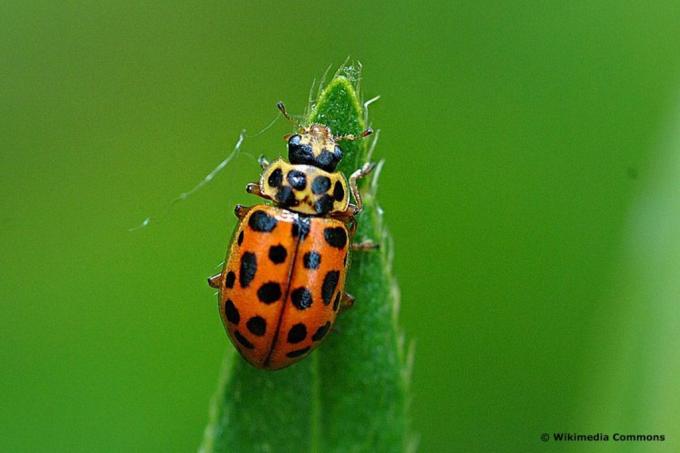
- Length: 3 - 4 mm
- Appearance: 19 black spots on the wings, yellowish pronotum with 6 black spots
- Food: aphids
- Special features: preferred habitats in swamp areas or wet biotopes in the garden with near-natural planting
Types of P - U
Poplar ladybug (Oenopia conglobata)
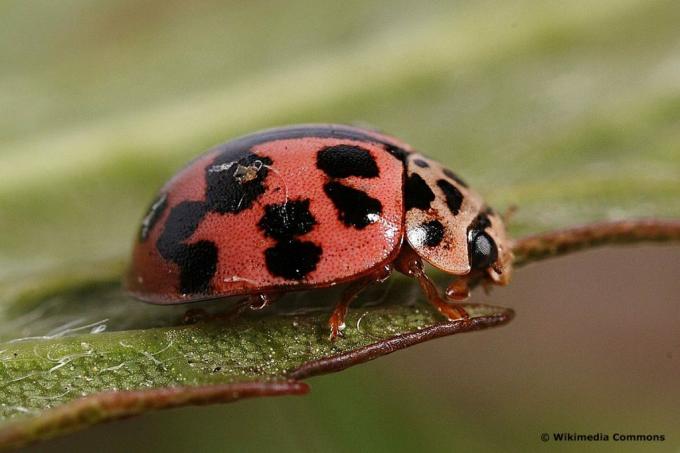
- Length: 3.5 - 5 mm
- Appearance: oval body shape, octagonal spots on each wing, light beige pronotum with 7 black spots
- Food: aphids
- Special features: preferred wintering quarters in deciduous trees such as poplars, elms or oaks
Knight bug (Lygaeus equestris)

- Length: 11-12 mm
- Appearance: black spots forming a cross, circular white spot on the lower back
- Food: sap from swallowwort, spring Adonis, dandelion
- Special features: prefers to eat poisonous plants, whose poison it stores and becomes inedible for predators
Swallowwort bug (Tropidothorax leucopterus)

- Length: 9-10 mm
- Appearance: two black spots on the back of the head, two triangular spots and semi-oval spots on the sides
- Diet: swallowwort, cypress milkweed
- Special features: the warning gear is sufficient that birds do not eat them
Scarlet stub beetle (Endomychus coccineus)

- Length; 4 - 6 mm
- Appearance: oval body, wide black stripe on the pronotum, two large black spots on the wings
- Food: mushrooms or Mushrooms, rotten leaves
- Special features: occasional brood parasitism in earth wasps
Seven-spotted ladybird (Coccinella septempunctata)
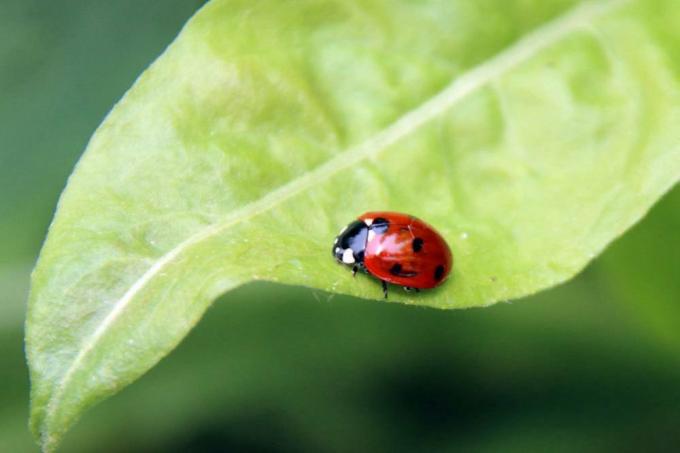
- Length: 5.2 - 8 mm
- Appearance: 3 black points per wing, in the middle a large black point with two white spots on the sides
- Food: aphids
- Special features: popular domestic beneficial organism
Types from V - Z
Variable flat ladybird (Hippodamia variegata)

- Length: 3 - 5.5 mm
- Appearance: rather narrow, elongated body, black patch on the neck with a white border, 3 or 6 black points
- Diet: aphids, scale insects
Twenty-four spotted ladybird (Subcoccinella vigintiquatuorpunctata)

- Length: 3 - 4 mm
- Appearance: 3 overgrown black spots on the pronotum, 12 spots on the wings
- Food: carnations, beets, potatoes, alfalfa, clover
- Special features: there are only traces of feeding on the upper side of leaves, a female lays up to 300 eggs on forage plants
Note: The twenty-four spotted ladybird is not a beneficial insect like many of its relatives among the red beetles with black spots, but a pest due to its food preferences.
White-spot ground bug (Melanocoryphus albomaculatus)

- Length: 6.9 - 7.3 mm
- Appearance: black head, two hook-shaped black spots on the pronotum, black round spots in the middle of the forewings, white round spot on a dark background on the abdomen
- Diet: swallowwort, red foxglove, ragweeds
- Special features: occurs in Central Europe only in heat islands with a mild climate
Bryony Ladybird (Henosepilachna argus)

- Length: 6 - 8 mm
- Appearance: 12 sharply defined black points, fine and densely hairy
- Food: cucurbits such as bryos, melons
- Special features: damage caused by feeding on host plants, in Europe mainly found on beets
Two-spotted fall beetle (Cryptocephalus bipunctatus)
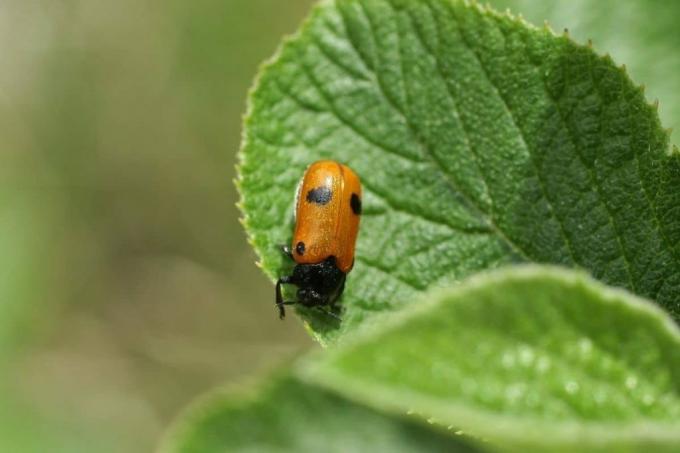
- Length: 4 - 6 mm
- Appearance: black head and pronotum, 2 large black spots in the back area, 2 smaller black spots in the shoulder area, shiny
- Diet: pollen, leaves of birch, Oak, Alder, hazel, willow
Two-spot ladybird (Adalia bipunctata)

- Length: 3 - 5 mm
- Appearance: oval body, black legs, very short antennae thickened at the end, a black point in the middle of each wing-cover
- Food: aphids, leaf fleas
- Special features: color variations with black base tone and red dots possible
frequently asked Questions
Fire bugs have very small forewings, but they are not suitable for flying.
Yes, color variations are not uncommon within a species, which makes it much more difficult to identify the beetle.
Bugs species like the fire bug do no harm, but if certain species like the knight bug occur in large quantities, plants can be permanently weakened.
